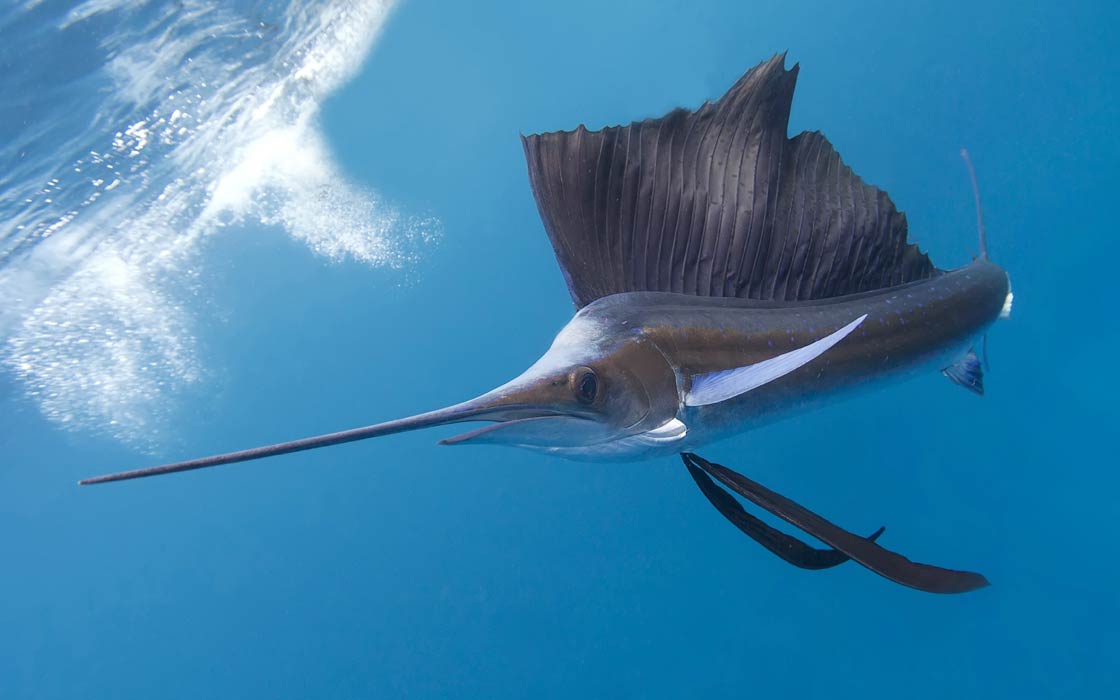Sailfish – the world’s fastest fish?
When it comes to speed in the animal kingdom, the cheetah is often considered the reigning champion, with its lightning-fast sprints clocking in at up to 70 miles per hour. But what if I told you there’s a fish that could give the cheetah a run for its money in a race? Meet the sailfish – the world’s fastest fish and a marvel of the sea.
Sailfish are known for their incredible speed and agility, able to reach speeds of up to 68 miles per hour, making them the fastest fish in the ocean. Their sleek bodies and long, pointed bills make them perfectly adapted to life in the open water, where they hunt for their favorite prey – small fish, squid, and crustaceans.
But what sets sailfish apart from other fast-swimming fish is their unique hunting technique. Using their impressive speed, sailfish will corral schools of prey into tight groups before attacking with their long, sharp bills. This strategy, known as “herding,” allows sailfish to catch multiple prey items in a single strike, making them one of the most efficient predators in the sea.
How do sailfish achieve such incredible speeds?
Much like a cheetah’s muscular legs and flexible spine, a sailfish’s body is built for speed. Their streamlined shape and powerful muscles allow them to slice through the water with ease, while their large dorsal fin, known as a sail, helps to stabilize their body during high-speed turns.
Sailfish aren’t just fast – they’re also incredibly intelligent
Recent research has shown that sailfish are capable of problem-solving and learning from their experiences, suggesting that they may be more intelligent than previously thought.
So the next time you’re out on the water, keep an eye out for these incredible creatures. The sailfish’s speed and agility are a testament to the incredible diversity and adaptability of life on Earth – and a reminder that there’s always something new and amazing to discover in the natural world.
The sailfish is the fastest fish in the world, and one that many avid anglers would love to have as a trophy over their fireplace. What is it, apart from its amazing speed, that sets it apart from other sea creatures and that has captured the imagination of so many people?
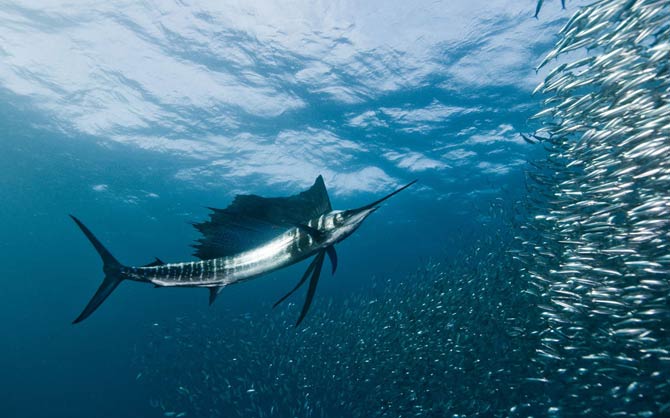
Classification
- Kingdom: Animalia
- Phylum: Chordata
- Class: Actinopterygii
- Order: Istiophoriformes
- Family: Istiophoridae
- Genus: Istiophorus
- Species:
- Indo-Pacific sailfish (Istiophorus platypterus)
- Atlantic sailfish (Istiophorus albicans)
One or two species?
Most scientists say that the same species of sailfish exists in all the world’s waters: Istiophorus platypterus. However, there are those who believe that the Atlantic fish of this family should be treated separately as Istiophorus albicans. Still, no exceptionally strong genetic proof can be found to confirm this thesis in 100%. Despite this, both species are mentioned in many publications.
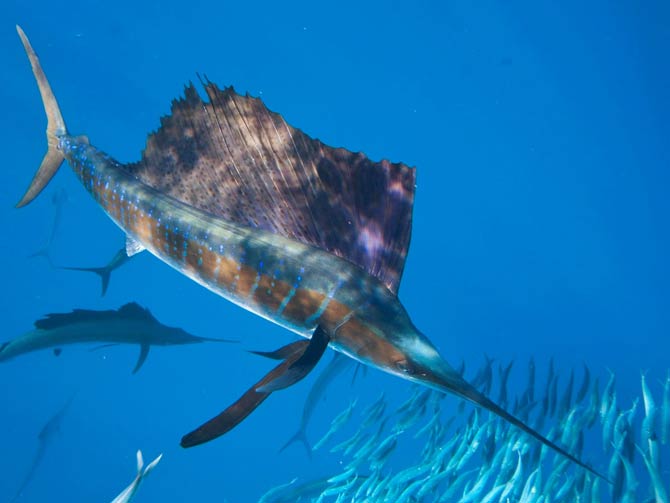
Occurrence
Sailfish can be found practically all over the world, which is why it is called a cosmopolitan species. It occurs in oceans, tropical and moderately warm waters, as well as the Red and Mediterranean Seas. It mostly swims near the surface, at a depth not exceeding 40 meters (130 ft). Although it sometimes wanders deep into the ocean, it definitely prefers being close to the coasts of islands and land.
The sailfish is found in the western Pacific from latitudes 45° to 50° N and latitudes 40° to 35° S and in the cooler eastern Pacific between 35° N and 35° S. In the western Indian Ocean, the distribution area extends north of 45° south latitude, in the east north of 35° south latitude. In the north, the distribution area is limited by the coast of South Asia. The fish also live in the Red Sea and migrate to the Mediterranean Sea through the Suez Canal.
In the Atlantic, the Atlantic sailfish population occurs between latitude 40°N northwest and latitude 50°N northeast and latitude 40°S southwest and latitude 32°S southwest. Besides the Mediterranean, both sailfish populations only have contact with each other on the coast of South Africa and can mix.
Sailfish prefer water that is between 21 and 28°C (70 – 82℉) and stay above the thermocline, although they can dive deeper.
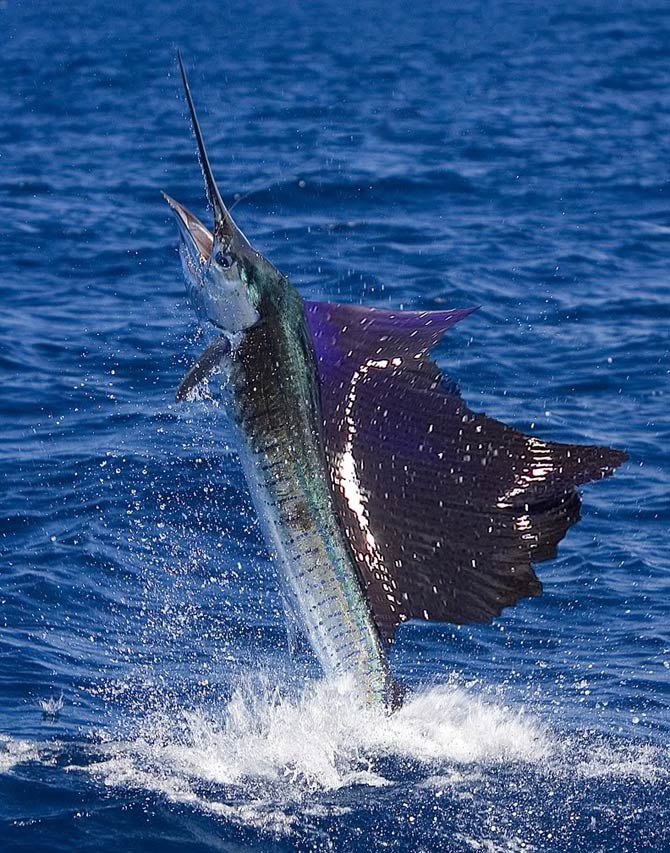
Characteristic
Physique
The most distinctive feature of a sailfish is its sail-shaped fin, which sometimes extends above the water’s surface. The dorsal fin is blue in color and covered with black spots.
The body of the sailfish is elongated and strongly flattened laterally. They usually reach lengths of about 2.5 meters. The maximum length is 3.80 meters (12.5ft). The fish reach a maximum weight of 50 to 100 kg (110 – 220 lb). Very large specimens are always females.
The upper side of the fish is dark blue, the flanks light blue with brown markings and about 20 longitudinal stripes made up of many light blue dots. The abdomen and the base of the first and second anal fins are silvery white. The membrane of the large first dorsal fin is dark blue or almost black with scattered small, round, black dots. The remaining fins are blackish brown or dark blue.
The size of the sailfish’s dorsal fin is twice the height of the body.
The back of the sailfish is blue-gray, and its body is decorated with stripes of dark spots. The scales – which is typical of this species – are large and elongated.
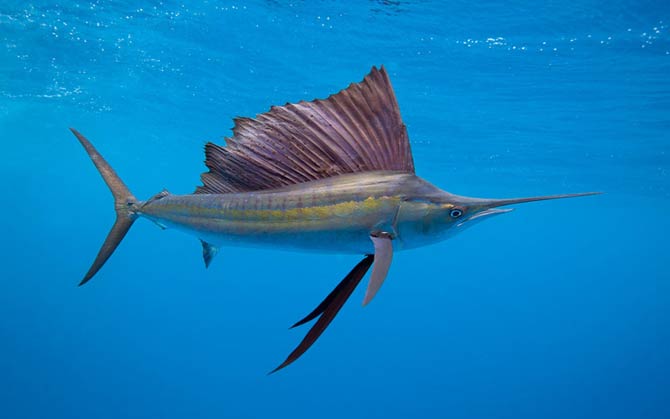
Sailfish – the fastest fish in the world?
Among other species, sailfish is distinguished primarily by speed.
Sailfish are said to be able to reach top speeds of 40 to 59 knots (approx. 75-110 km/h / 46.6 – 68 mph) and are therefore among the fastest fish. However, more recent studies cast doubt on this information, according to which sailfish do not exceed speeds of 36 km/h (22 mph). A new study shows that the theoretical maximum speed that can be expected is 36 to 45 km/h (22 – 28 mph).
Diet
Sailfish feed almost entirely on small fish, but they also like to eat crustaceans and cephalopods.
Hunting
The sailfish kills its victims with a long, thin rostrum, that is, the elongated part of the upper lip.
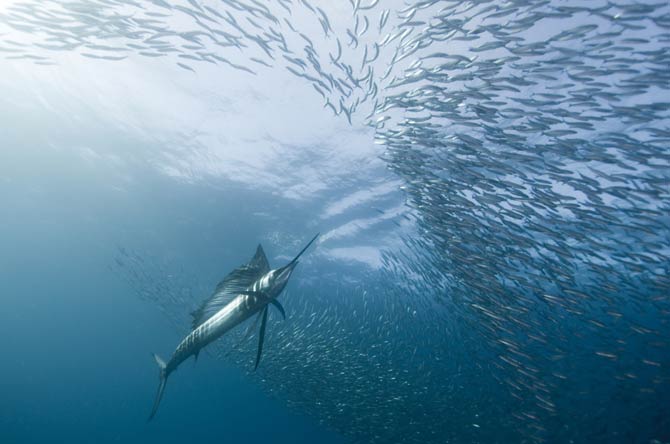
Lifestyle
Sailfish usually form small groups, consisting of 3 to 30 individuals. They are also found in looser formations that occupy a very large area. Spawning usually takes place in summer in open water areas.
Sailfish and man
This unusual fish is the object of desire of many fishermen. There are even sports fishing for sailfish. When caught with a fishing rod, it can fight for a long time and even jump out of the water to great heights – all in order to free itself from the hook.
Sailfish are also used in the food sector, as fresh, frozen and smoked meat.
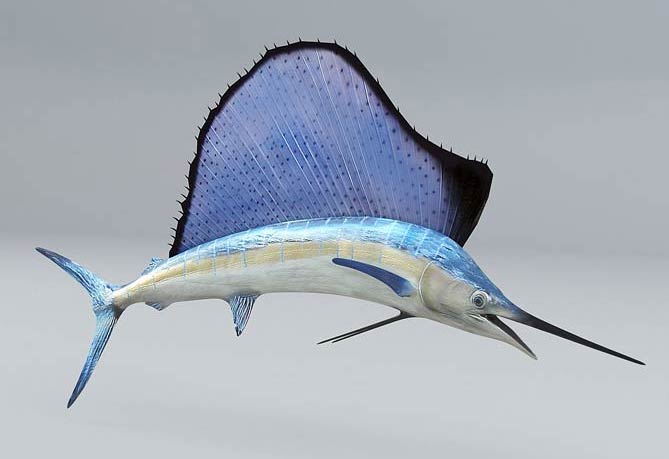
Detailed data and dimensions (size)
- Average body length: 100-150 cm / 3.3 – 4.9 ft; record 380 cm / 12.5ft
- Weight: 10-40 kg (22- 88 lb) ; record 100.2 kg (220.9 lb)
- The maximum dimensions of the dorsal fin:
- height 100 cm (3.3 ft)
- length 170 cm (5.6 ft)
- Speed:
- previously estimated to reach maximum swimming speeds of 125 km/h (77.7 mph)
- research published in 2015 and 2016 indicates sailfish do not exceed speeds between 10–15 m/s (36 – 54 km/h / 22.4 – 33.6 mph).
- During predator–prey interactions, sailfish reached burst speeds of 7 m/s (25 km/h / 15.7 mph) and did not surpass 10 m/s (35 km/h / 22.4 mph).
- Number of vertebrae: 24
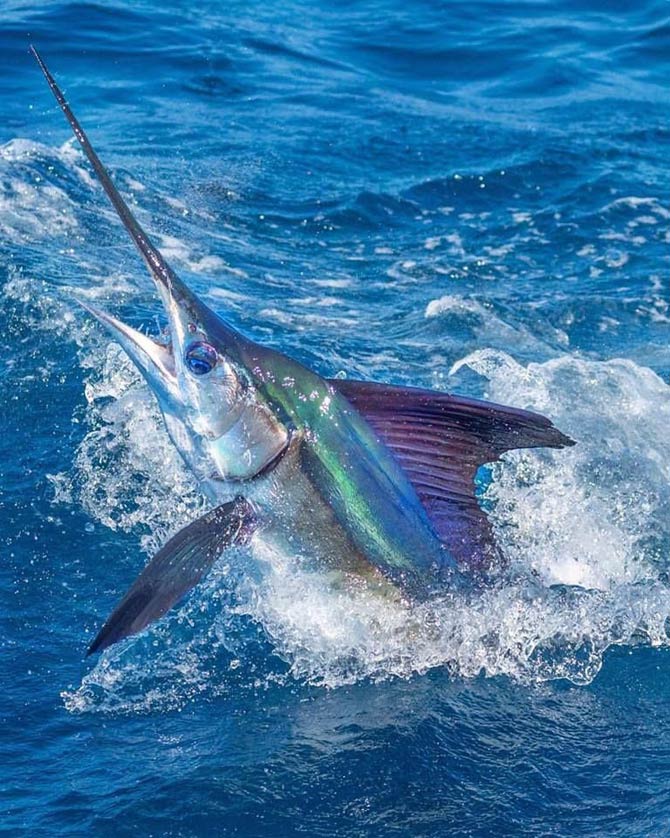
Sailfish – interesting facts
- The largest sailfish was 380 (12.5 ft) centimeters long, and the heaviest one weighed over 100 kilograms (220 lb).
- Sailfish meat is used in the preparation of sushi and sashimi.
- Sailfish are found in warm and temperate waters around the world, including the Atlantic and Pacific Oceans, the Mediterranean Sea, and the Caribbean Sea.
- Sailfish are named for their distinct dorsal fin, which can be as long as their body and resembles a sail. This fin is used for thermoregulation and can also be used to intimidate predators or attract mates.
- Sailfish are not only the fastest fish in the ocean, but also one of the fastest animals on the planet. Their top speed of 68 miles per hour is faster than that of most cars on the highway.
- Sailfish are known for their spectacular acrobatics, often leaping out of the water in a display known as “tail-walking.” This behavior is thought to be a defense mechanism to dislodge parasites or to attract potential mates.
- Sailfish are apex predators, meaning they are at the top of the food chain in their ecosystem. They have few natural predators, but are often caught by humans for sport or food.
- Sailfish have a unique hunting strategy, using their speed and agility to corral prey into tight schools before attacking with their long bills. This strategy is highly effective and allows sailfish to catch multiple prey items in a single strike.
- Sailfish have a lifespan of up to 13 years and can grow up to 12 feet long and weigh up to 220 pounds. However, most sailfish caught by humans are much smaller, averaging around 6 to 8 feet in length.
- Sailfish are not currently considered an endangered species, but they are listed as a species of “least concern” by the International Union for Conservation of Nature. However, their populations are declining due to overfishing and habitat destruction.
- Sailfish are not only fast and intelligent, but also beautiful. Their bodies are covered in iridescent blue and silver scales, making them one of the most striking fish in the ocean.
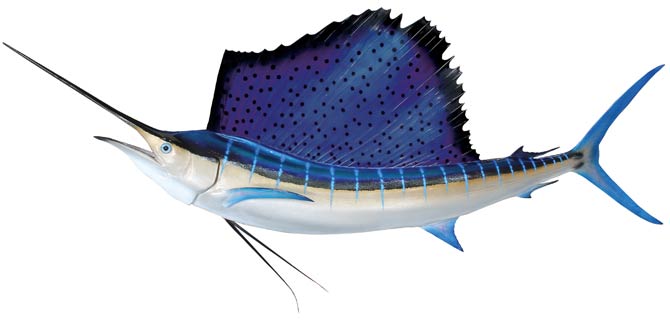
Recommended
- The fastest animals
- The fastest fish
- Sharks – myths and facts
- Sharks – killers from the depths
- Great white shark
- Megalodon
- Whale shark – largest fish
- Basking shark – the second largest fish
- Greenland shark
- Hammerhead shark
- Tiger shark

